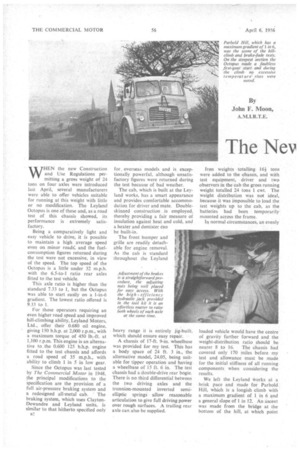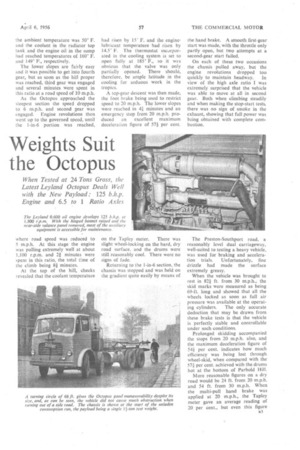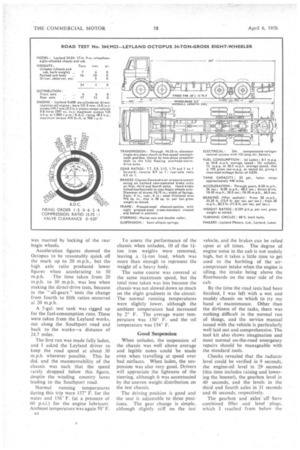The Nev Weights Suit the Octopus
Page 36

Page 37

Page 38

Page 39

If you've noticed an error in this article please click here to report it so we can fix it.
When Tested at 24 Tons Gross, the Latest Leyland Octopus Deals Well with the New Payload: 125 b.h.p. Engine and 6.5 to 1 Ratio Axles By John F. Moon, A.M.I.R.T.E.
WHEN the new Construction and Use Regulations permitting a gross weight of 24 tons on four axles were introduced last April, several manufacturers were able to offer vehicles suitable for running at this weight with little or no modification. The Leyland Octopus is one of these and, as a road test of this chassis showed, its performance is extremely satisfactory.
Being a comparatively light and easy vehicle to drive, it is possible to maintain a high average speed even on minor roads-, and the fuelconsumption figures returned during the test were not excessive, in view of the speed. The top speed of the Octopus is a little under 32 m.p.h. with the 6.5-to-1 ratio rear axles fitted to the test vehicle.
This axle ratio is higher than the standard 7.33 to 1, but the Octopus was able to start easily on a I-in-6 gradient. The lowest ratio offered is 9.33 to 1.
For those operators requiring an even higher road speed and improved hill-climbing ability, Leyland Motors. Ltd., offer their 0.680 oil engine, giving 150 b.h.p. at 2,000 r.p.m., with a maximum torque of 450 lb.-ft. at 1,100 r.p.m. This engine is an alternative to. the 0.600 125 b.h.p. engine fitted to the test chassis and affords a road speed of 35 m.p.h., with ability to climb I in 5 in low gear.
Since the Octopus was last tested by The Cotnntercial Motor in 1948, the principal modifications to the specification are the provision of a full air-pressure braking system and a redesigned all-metal cab. ' The braking system, which uses ClaytonDewandre and Leyland units, is similar to that hitherto specified only
re for overseas models and is exceptionally powerful, although unsatisfactory figures were returned during the test because of bad weather.
The cab, which is built at the Leyland works, has a smart appearance and provides comfortable accommodation for driver and mate. Doubleskinned construction . is employed, thereby providing a fair measure of insulation against heat and cold, and a heater and demister can be built-in.
The front bumper and grille are readily detach able for engine removal. As the cab is standard throughout the Leyland heavy range it is entirely jig-built. which should ensure easy repair.
A chassis of 17-ft. 9-in, wheelbase was provided for my test. This has a body space of 24 ft. 3 in., the alternative model, 24.05, being suitable for tipper operation and having a wheelbase of 15 ft. 6 in. The test chassis had a double-drive rear bogie. There is no third differential between the two driving axles and the trunnion-mounted inverted semielliptic springs allow reasonable articulation to give full driving power over rough surfaces. A trailing rear axle can also be supplied.
Iron weights totalling 16i tons were added to the chassis, and with test equipment, driver and two observers in the cab the gross running weight totalled 24 tons 1 cwt. The weight distribution was not ideal, because it was impossible to load the test weights up to the cab, as the batteries had been temporarilymounted across the frame.
In normal circumstances, an evenly loaded vehicle would have the centre of gravity farther forward and the weight-distribution ratio should be nearer 8 to 16. The chassis had covered only 170 miles before my test and allowance must be made for the initial stiffness of all running components when considering the results.
We left the Leyland works at a brisk pace and made for ParboId Hill, which is a longish climb with a maximum gradient of 1 in 6 and a general slope of 1 in /2. An ascent was made from the bridge at the bottom of the hill, at which point
the ambient temperature was 50° F. and the coolant in the radiator top tank and the engine oil in the sump had reached temperatures of 160' F. and 149 F., respectively.
The lower slopes are fairly easy and it was possible to get into fourth gear, but as soon as the hill proper was reached, third gear was engaged and several minutes were spent in this ratio at a road speed of 10 m.p.h.
As the Octopus approached the steepest section the speed dropped to 6 m.p.h. and second gear was engaged. Engine revolutions then went up to the governed speed, until the 1-in-6 portion was reached, where road speed was reduced to 5 m.p.h. At this stage the engine was pulling extremely well at about 1,100 r.p.tn. and 2* minutes were spent in this ratio, the total time of the climb being 81 minutes.
At the top of the hill, checks revealed that the coolant temperature had risen by 15' F. and the engine lubricant temperature had risen by 14.5' F. The thermostat incorporated in the cooling system is set to open fully at 185° F., so it wes obvious that the valve was only partially opened. There should, therefore, be ample latitude in the cooling for arduous work in the tropics.
A top-gear descent was then made, the foot brake being used to restrict speed to 20 m.p.h. The lower slopes were reached in 411 minutes and an emergency stop from 20 m.p.h. pro.duced an excellent maximum deceleration figure of 571 per cent.
on the Tapley meter. There was slight wheel-locking on the hard, dry road surface, and the drums were still reasonably cool. There were no signs of fade.
Returning to the 1-in-6 section, the chassis was stopped and was held on the gradient quite easily by means of the hand brake. A smooth first-gear start was made, with the throttle only partly open, but two attempts at a second-gear start failed.
On each of these two occasions the chassis pulled away, but the engine revolutions dropped too quickly to maintain headway. In view of the high axle ratio I was extremely surprised that the vehicle was able to move at all in second gear. Both when climbing steadily and when making the stop-start tests, there was no sign of smoke in the exhaust, showing that full power was being obtained with complete combustion.
The Preston-Southport reasonably level dual carriageway, well-suited to testing a heavy vehicle, was used for braking and acceleration trials. Unfortunately, line drizzle had made the surface extremely greasy.
When the vehicle was brought to rest in 82-i ft. from 30 m.p.h., the skid marks were measured as being 69-ft. long and showed that all the wheels locked as soon as full air pressure was available at the operat ing cylinders. The only accurate deduction that may be drawn from these brake tests is that the vehicle is perfectly stable and controllable under such conditions.
Prolonged skidding accompanied the stops from 20 m.p.h. also, and the maximum deceleration figure of 541 per cent. indicates bow much efficiency was being lost through wheel-skid, when compared with the 571 per cent. achieved with the drums hot at the bottom of Parbold Hill.
More reasonable figures on a dry road would be 24 ft. from 20 m.p.h. and 54 ft. from 30 m.p.h. When the multi-pull hand brake was applied at 20 m.p.h., the Tapley meter gave an average reading of 20 per cent., but even this figure road, a was marred by locking of the rear bogie wheels.
Acceleration figures showed the Octopus to be reasonably quick off the mark up to 20 m.p.h,, but the high axle ratio produced lower figures when accelerating to 30 m.p.h. The time taken from 20 m.p.h. to 30 m.p.h. was less when making the direct-drive tests, because in the " all-gears " tests the change from fourth to fifth ratios occurred at 20 m.p.h.
A 5-gal. test tank was rigged up for the fuel-consumption runs. These were taken from the Leyland works, out along the Southport road and back to the works-a distance of 24.7 miles.
The first run was made fully laden, and I asked the Leyland driver to keep the road speed at about 30 m.p.h. wherever possible. This he did, and the manceuvrability of the chassis was such that the speed rarely dropped below this figure, despite the winding country lanes leading to the Southport road.
Normal running temperatures during this trip were 157" F. for the water and 156° F. (at a pressure of 60 psi.) for the engine lubricant. Ambient temperature was again 50° F.
114 To assess the performance of the chassis when unladen, 10 of the 1ton iron weights were removed, leaving a li-ton load, which was more than enough to represent the weight of a heavy body.
The same course was covered at the same maximum speed, but the total time taken was less because the chassis was not slowed down so much on the slight gradients in the circuit. The normal running temperatures were slightly lower, although the ambient temperature had increased by 2° F. The average water temperature was 150' F. and the oil temperature was 154° F.
Good Suspension When unladen, the suspension of the chassis was well above average and legible notes could be made eVen when travelling at speed over bad surfaces. When laden, the suspension was also very good. Drivers will appreciate the lightness of the steering, although it was accentuated by the uneven weight distribution on the test chassis.
The driving position is good and the seat is adjustable to three positions. The gear change is simple, although slightly stiff On the test vehicle, and the brakes can be relied upon at all times. The degree of engine noise in the cab is not unduly high, but it takes a little time to get used to the burbling of the aircompressor intake when the engine is idling, the intake being above the floorboards on the near side of the cab.
By the time the road tests had been finished, I was left with a wet and muddy chassis on which to try my hand at maintenance. Other than the dirtiness of the tasks, there was nothing difficult in the normal run of things, and the service manual issued with the vehicle is particularly well laid out and comprehensive. The tool kit also shows imagination and most normal on-the-road emergency repairs should be manageable with the standard tools.
Checks revealed that the radiator level could be verified in 9 seconds, the engine-off level in 29 seconds (this time includes raising and lowering the bonnet), the gearbox level in 40 seconds, and the levels in the third and fourth axles in 31 seconds and 46 seconds, respectively:
The gearbox and axles all have combined filler , and • level plugs. which I reached from below the
vehicle, as would be necessary had a body been fitted. A pit would have made things easier, but proved not to be essential.
One of the front wheels was changed in 10 minutes, and the job was made considerably lighter by the efficient hydraulic jack provided in the kit. The spare wheel is not difficult to reach and is secured by a clamp plate and bolt with a sensibly sized handle.
The brakes may be adjusted either with the wheels on the ground and by inserting a feeler between the drums and the facings, or by jacking Lip the wheels and tightening up the shoes until the wheel is locked and then slackening off the adjusters until the wheel is just free to revolve, I chose the second method and jacked up both wheels of each axle at once, the total time taken being 14 minutes. The adjustment is extremely simple, but I was annoyed to find that different-sized nuts are used on the bogie-wheel adjusters. As these jobs are all likely to be done at the same time, the obvious thing seems to me to cut down the number of tools involved by making all the nuts of the same size.
The main fuel filter is located on the near side of the cylinder head at the front, where it is readily accessible for routine maintenance. The filter element is of the Pack-andSack type and consists of felt pads encased in a, cloth sleeve. The time taken to remove and replace this element was 2f minutes.
It is recommended that the cloth should be changed regularly, whenever the felt element is cleaned. After replacing the element, the fuel system was bled in 2 minutes with the engine running.
Tappet clearances were checked by two fitters in 36 minutes. The engine was turned over by hand and the timing plunger, which locks the flywheel, was used when setting the clearances.
My last task was to fit a new fuse wire in the switch and control panel. This is located on the rear cab panel to the right of the driver's seat, and the cover may be removed by undoing the securing screw with a coin. From start to finish the fuse wire was replaced in 55 seconds.
The Octopus has obviously been made as easy to service as possible with a vehicle of this size, and there can be no excuse for incomplete maintenance.




















































































